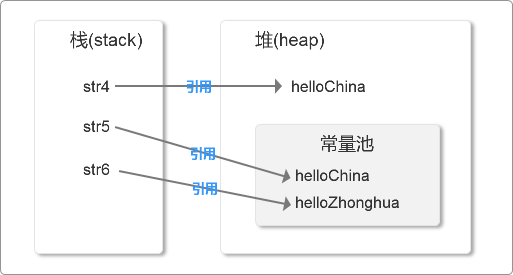String可以说是Java中使用最多最频繁、最特殊的类,因为同时也是字面常量,而字面常量包括基本类型、String类型、空类型。
一. String的使用
1. String的不可变性
/**
* The {@code String} class represents character strings. All
* string literals in Java programs, such as {@code "abc"}, are
* implemented as instances of this class.
* <p>
* Strings are constant; their values cannot be changed after they
* are created. String buffers support mutable strings.
* Because String objects are immutable they can be shared. For example:
* ...
*/
public final class String {
private final char value[];
}
String对象一旦在堆中创建出来,就无法再修改。因为String对象放在char数组中,该数组由final关键字修饰,不可变。
2. 定义一个字符串
/**
* 定义一个字符串
*/
String str1 = "helloworld";
String str2 = "helloworld";
//也可以,但基本不这样写
String str3 = new String("helloworld");
System.out.println(str1 == str2);
System.out.println(str1 == str3);
//运行结果 true, false
上面三句代码怎么理解呢?这里需要先引入一个概念,字符串常量池。
字符串常量池是一块特殊的独立内存空间,放在Java Heap中 { 在Jdk7.0之前字符串常量池存放在PermGen中,Jdk7.0的时候移动到了Java Heap(在堆中仍然是独立的),Jdk8.0的时候去掉了PermGen,用Metaspace进行取代 } ,Java内存模型不是本章讨论的重点。
str1和str2引用的字符串字面量就在字符串常量池中,而str3引用的对象在Java Heap中。
怎么,还不太好理解?举个例子
工作一天,到下班时间了,准备看会儿金瓶.,算了,《三国演义》,打开小说网站,在线阅读;过了半个小时,女票回家了,看《三国演义》也是她想做的事儿,我看网址发给她,好,她也开始看了,再过半个小时,我爸回来了,他也是三国迷,但是他不喜欢在线看,因此在书店买了一本看。
上面提到的小说网站就是一个字符串常量池,包含了很多字符串字面量,如《三国演义》、《西游记》、《红楼梦》等,每个字符串字面量在常量池中保持独一份,无论谁进网站看《三国演义》都是同样的网址和同样的内容。
我和女票就是str1和str2,我们看的都是同一个网站的《三国演义》,不仅内容一样,引用的地址也一样(字符串常量池中保留了唯一的“helloworld”),因此str1 == str2 运行结果为true
而我爸就是str3,与我和女票都不一样,虽然看的内容也是《三国演义》,但是通过实体书籍来看,引用地址不一样,同时一本书籍不支持多个人同时看(字符串对象在java heap中,且每次new都会新建一个对象),因此str1 == str3 运行结果为false。
一个字符串字面量总是引用String类的同一个实例,因为被String.intern()方法限定了,同样我们可以调用该方法将堆中的String对象放到字符串常量池中,这样做可以提升内存使用效率,同时可以让所用使用者共享唯一的实例。
System.out.println(str1 == str3.intern());
//运行结果为true
那么该方法的实现逻辑是怎么样的呢,我们看一下源码
/**
* Returns a canonical representation for the string object.
* <p>
* A pool of strings, initially empty, is maintained privately by the
* class {@code String}.
* <p>
* When the intern method is invoked, if the pool already contains a
* string equal to this {@code String} object as determined by
* the {@link #equals(Object)} method, then the string from the pool is
* returned. Otherwise, this {@code String} object is added to the
* pool and a reference to this {@code String} object is returned.
* <p>
* It follows that for any two strings {@code s} and {@code t},
* {@code s.intern() == t.intern()} is {@code true}
* if and only if {@code s.equals(t)} is {@code true}.
* <p>
* All literal strings and string-valued constant expressions are
* interned. String literals are defined in section 3.10.5 of the
* <cite>The Java™ Language Specification</cite>.
*
* @return a string that has the same contents as this string, but is
* guaranteed to be from a pool of unique strings.
*/
public native String intern();
我们发现这是一个native方法,看一下注释,发现str3.intern()方法大致流程是:
当执行intern()时,会先判断字符串常量池中是否含有相同(通过equals方法)的字符串字面量,如果有直接返回字符串字面量;如果不含,则将该字符串对象添加到字符串常量池中,同时返回该对象在字符串常量池的引用。
返回的引用需要赋值才可,否则还是会指向堆中的地址,即:
String str4 = new String("helloChina");
System.out.println(str4.intern() == str4);//false
str4 = str4.intern();
String str5 = "helloChina";
String str6 = "helloZhonghua"
System.out.println(str4 == str5);//true
下面我们看一下内存结构

3. 再次赋值给已定义的字符串
str6 = "helloHuaxia";
我们开始已经说了String是由final关键字修饰,不可变,那么此时在内存中如何体现呢?

4. String 对 “+” 的处理
String str7 = "good good" + " study";
String str8 = "good good study";
system.out.println(str7 == str8);
通过编译工具后得到
String str7 = "good good study";
String str8 = "good good study";
因此我们可以发现编译器在编译期间就是进行变量合并,而不会在常量池中创建三个对象 “good good”,“ study”,"good good study"。str7 == str8 运行结果 true。
但如果这样
String str9 = "good good ";
String str10 = str9 + "study";
system.out.println(str8 == str10);//false
这时运行结果为false,通过String变量 + 字符常量方式得到的结果会在堆中,不在常量池中,当然可以通过intern()方法放进常量池中,同时不仅“+”如此,调用substring(),toUpperCase(),trim()等返回的都是String在堆中的地址。
5. String常用的方法
//str1 == "hello,world ";
//获取长度
str1.length()//12;
//截取位置2到5之间的字符串(包括位置2,不包括位置5,从0开始)
str1.substring(2,5);//"llo"
//判断是否含有字符串“ello”
str1.contains("ello");//true,通过indexOf实现
//获取ello在str1中的开始位置
str1.indexOf("ello");//1
//将字符串转化为字符串数据
str1.split(",");//["hello","world"]
//去掉字符串两侧空格
str1.trim();//"hello,world"
二. 总结
本文从String的不可变性,String创建时字面量和String对象的不同,字符串字面量常量池,字符串的内存结构,常用的String相关方法的描述,若有不对之处,请批评指正,望共同进步,谢谢!